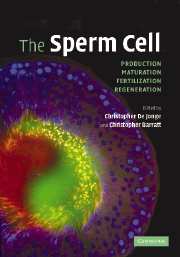Book contents
- Frontmatter
- Contents
- Preface
- List of contributors
- 1 Mammalian spermatogenesis and sperm structure: anatomical and compartmental analysis
- 2 Sperm chromatin stability and susceptibility to damage in relation to its structure
- 3 Genomic and proteomic approaches to defining sperm production and function
- 4 Sperm maturation in the human epididymis
- 5 Controls of sperm motility
- 6 Regulation of capacitation
- 7 Reactive oxygen species: friend or foe
- 8 Testing sperm manufacturing quality: the sperm–zona binding assay
- 9 Genetics: a basic science perspective
- 10 Sex chromosome abnormalities and male infertility: a clinical perspective
- 11 Epigenetic patterning in male germ cells: importance of DNA methylation to progeny outcome
- 12 The DAZ gene family and human germ cell development from embryonic stem cells
- Index
2 - Sperm chromatin stability and susceptibility to damage in relation to its structure
Published online by Cambridge University Press: 14 August 2009
- Frontmatter
- Contents
- Preface
- List of contributors
- 1 Mammalian spermatogenesis and sperm structure: anatomical and compartmental analysis
- 2 Sperm chromatin stability and susceptibility to damage in relation to its structure
- 3 Genomic and proteomic approaches to defining sperm production and function
- 4 Sperm maturation in the human epididymis
- 5 Controls of sperm motility
- 6 Regulation of capacitation
- 7 Reactive oxygen species: friend or foe
- 8 Testing sperm manufacturing quality: the sperm–zona binding assay
- 9 Genetics: a basic science perspective
- 10 Sex chromosome abnormalities and male infertility: a clinical perspective
- 11 Epigenetic patterning in male germ cells: importance of DNA methylation to progeny outcome
- 12 The DAZ gene family and human germ cell development from embryonic stem cells
- Index
Summary
Introduction: the malleable sperm genome
Over the last decade, our assumptions and ideas about the stability of the mammalian sperm genome have gone through a gentle and progressive change. Historically, we viewed the sperm genome as tightly packaged into a virtual crystalline state with very little biochemical accessibility. We now understand that in many cases of decreased male fertility sperm deoxyribonucleic acid (DNA) structure loses much of this inaccessibility and that the DNA is susceptible to damage. More recently, evidence has emerged from many different laboratories that spermatozoa contain nucleases that are capable of digesting their compact DNA. These data suggest that the sperm genome may be less stable than we thought and might even be flexible enough to regulate its own stability in a manner similar to somatic cells. In this review, we will explore the current status of the stability of the mammalian sperm genome in the context of what is known about sperm chromatin structure.
Sperm chromatin structure and fertility
Before discussing DNA damage as it relates to sperm chromatin structure we will briefly review those aspects of sperm chromatin, both known and suspected, that pertain to this discussion. During spermiogenesis the haploid sperm chromatin undergoes one of the most significant changes known in biology. All of the histones are replaced first by transition proteins, then by protamines (Meistrich et al., 2003).
- Type
- Chapter
- Information
- The Sperm CellProduction, Maturation, Fertilization, Regeneration, pp. 31 - 48Publisher: Cambridge University PressPrint publication year: 2006
- 7
- Cited by



